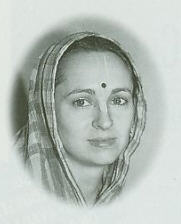
Urmila Devi Dasi
A COUSIN WITH WHOM I'd had no contact since joining the Hare Krsna movement sent me a card of congratulations when our son married. So I responded with some photos of our family and a card of pleasantries. She then sent me photos of her family and told me she and her husband were about to make a trip with her parents.
On that trip, her father, my mother's brother, died alone when he went to take a nap. Since my cousin and I were now writing, I took the opportunity to send her a note of sympathy, in which I quoted these words by Lord Krsna from the Bhagavad-gita:"For the soul there is never birth nor death. Nor having once been, does he ever cease to be. He is unborn, eternal, ever-existing, and primeval. He is not slain when the body is slain."
She wrote back, "Your view of death seems so true, yet difficult for the 'Westernized' mind to grasp. I wish we were better prepared for death and loss in our upbringing, education, community, and religion. Everywhere one turns there seem to be only messages of youth and life, and an ignoring and shunning of aging and death."
Actually, there has been a kind of "death education" in American public schools for more than a decade. As Snookie Dellinger, a parent, testified in 1984 to the U.S. Department of Education, "A survival game which my seventh-grade son participated in required him to eliminate five out of ten whom they did not have room for on a spaceship." Doris D'Antoni, another parent, spoke about the death education of her grandchildren: "In one program in our county, little first-graders made their own coffins out of shoe boxes."
In 1980, then president Reagan criticized government school programs where children "decided which members of their family should be left to die for the survival of the remaining ones." Some death education programs have children write a suicide note.
While this type of education may prepare a child to take his own life or the lives of others (something children are doing more and more of nowadays), it doesn't give a spiritual understanding of death or what to do at the crucial time when it comes.
Devotees of Krsna do not see death as a subject in any way unfit for children. Instead, we see death to be, as Krsna explains, simply a change of clothes. Death looms large for a materialist because it yanks away what he holds on to as his sources of pleasure. But for a devotee, death merely tests how well one has lived.
At death the soul fixes on what has been most important in life. The soul who thinks only of Krsna will not get another material body, required for those with material longings. Rather, the soul who perfects the art of dying will develop a spiritual body with which to serve Krsna forever.
Children who understand Krsna's simple and logical explanation of death look at life with tremendous joy and hope. Even two- and three-year-olds can easily make the connection if I must focus on Krsna at death, let me dedicate my body, mind, and words to Him during life.
I often remember my three-year-old friend Radha-Govinda Dasi. She always talked of Krsna's pastimes, imitating them in her play. She never displayed a child's usual possessiveness or envy, and she seemed little concerned with her external circumstances. Her parents trained her to rise daily before sunrise to worship the Deity of Krsna. At home and in my nursery school, she learned to think of Krsna at death.
On the day she gave up her body fourteen years ago, at age three, she had spent the morning dancing and chanting in the temple with great enthusiasm. Then she had helped her mother cook a feast, because it was the festival of Srila Prabhupada's appearance in this world. We had no doubt she left her material body while absorbed in love for Krsna, because she had loved Him throughout her life.
Our own daughter, about the same age, saw the death of Radha-Govinda, her best friend, as a great cause for celebration. "Why are you sad?" she would ask me. "Radha-Govinda is playing with Krsna!"
Urmila Devi Dasi, initiated in 1973, has worked in ISKCON education since 1983.
